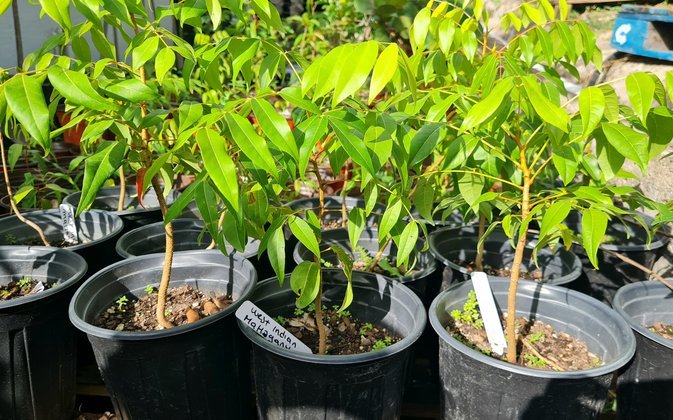Over the past year, the Public Entity’s reforestation team has been busy growing and caring for the young trees in its nursery that will be used to reforest different parts of the island. Their efforts have resulted in approximately 3,400 saplings in the nursery of various tree species that are native to Saba or have become naturalized over time.

The project focuses on growing 12 different tree species, including: Genip, Seagrape, West Indian Mahogany, West Indian-Almond, Gumbo-Limbo, Red Wood, Small-Leaf Fig, Big-Leaf Fig, Soursop, Mango, White Cedar and Fiddlewood. While the project has other trees species that it grows, those are grown less intensively.
The main tree species were carefully selected to be used in the project because of their resistance to drought, salt breeze and strong wind. These tree species grow in the tropical dry forests of Saba and are able to withstand the harsher conditions in the lower, coastal areas. It is forecast that Saba could experience less rainfall, and consequently more intense droughts, in the future as a result of climate change. It is, therefore, necessary that the trees used in the reforestation project are able to grow and thrive in dry conditions.
The saplings in the nursery were grown from seeds that were collected from native, wild trees and from seedlings that were found growing under their parent trees. Germinating seeds from wild trees is different than germinating seeds from garden fruit and vegetable plants. The reforestation team must recreate the same conditions that lead to the germination of tree species that occur naturally in wild forests. The seeds of each tree species sometimes require different conditions in order for them to germinate. The reforestation team has been able to germinate these seeds through a series of trial and error in order to find out what works and what does not work. To ensure the number of saplings in the nursery increases, the project team also collected seedlings of the same tree species. This was done by going into the forests and collecting the seedlings from under their parent trees.
With over 3,000 saplings growing, the nursery has reached its capacity of what it can hold. More room is being made at the hydroponics farm, where one of the greenhouses will be used as a second nursery to temporarily house the growing saplings until they are ready for outplanting. Once the saplings are outplanted, the greenhouse will be used again by the hydroponics farm for the growing of vegetables (as is its primary purpose).
Many of the saplings in the current nursery are almost ready for outplanting. From the start of the project, the reforestation team has been busy looking for land that is available and suitable for reforesting. This is still being looked into.
A goal of the project is to mitigate erosion and runoff. To achieve this goal, it is necessary that the saplings are outplanted on land in areas where erosion takes place. It is also important that the land is not too far away from the main road to allow for the team to access the site so that they can outplant the saplings and provide them with the care and maintenance they will need in the beginning. The land must also not be too steep to help ensure the safety of the team.
Several areas are currently being looked at as possible sites for reforesting with outplanting aimed to start in December.
GIS.
 Saba News News and Information from Saba Island, Dutch Caribbean
Saba News News and Information from Saba Island, Dutch Caribbean